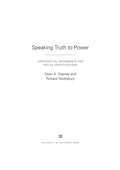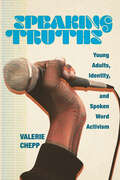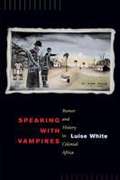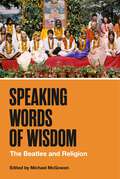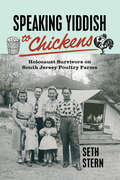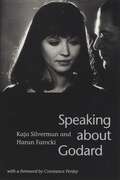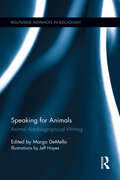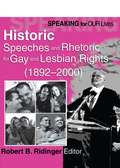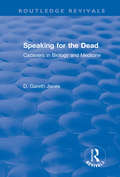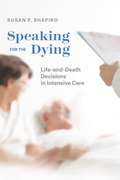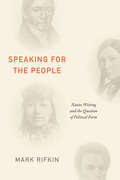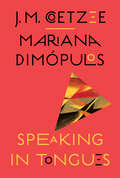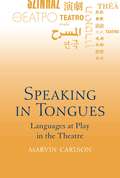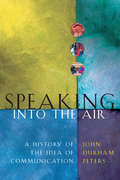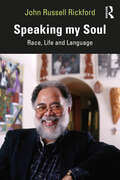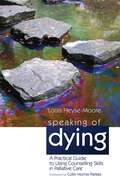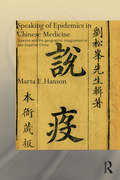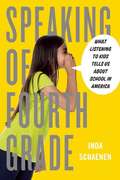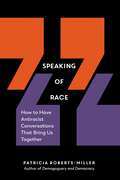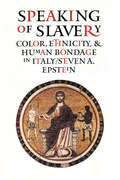- Table View
- List View
Speaking Truth to Power: Confidential Informants and Police Investigations
by Dean A. Dabney Richard TewksburyDomestic drug enforcement takes many forms, from the rural patrol officer who happens upon a small-scale mobile "shake and bake" methamphetamine lab during a routine traffic stop, to the city narcotics detective who initiates a low-level buy-bust operation that nets a few hits of crack cocaine on the street corner, to the local, state, and federal agents working in multiagency task forces that coordinate a sting operation that nets thousands of kilos of near-pure cocaine being transported by tractor-trailer. Regardless of the form, there is a high probability that these authorities have exploited access to known offenders and exerted pressure on those individuals to gather inside information on illicit drug sales. These confidential informants provide intelligence on the inner workings of drug operations in exchange for leniency or remuneration, providing a relatively cheap source of intelligence that fuels much of the ongoing war on drugs. In other instances, law enforcement authorities will reach out to members of the criminal underworld who are willing to provide valuable intelligence in exchange for money. Despite the central role of informants in contemporary police operations, little is known about the shadowy relationships among law enforcement, snitches, and offenders. Based on ethnographic fieldwork in the narcotics, homicide, and street-level vice operations in two major metropolitan police departments, Speaking Truth to Power takes readers to the front lines of the war on drugs to unravel this complex web of information exchange.
Speaking Truths: Young Adults, Identity, and Spoken Word Activism
by Valerie CheppThe twenty-first century is already riddled with protests demanding social justice, and in every instance, young people are leading the charge. But in addition to protesters who take to the streets with handmade placards are young adults who engage in less obvious change-making tactics. In Speaking Truths, sociologist Valerie Chepp goes behind-the-scenes to uncover how spoken word poetry—and young people’s participation in it—contributes to a broader understanding of contemporary social justice activism, including this generation’s attention to the political importance of identity, well-being, and love. Drawing upon detailed observations and in-depth interviews, Chepp tells the story of a diverse group of young adults from Washington, D.C. who use spoken word to create a more just and equitable world. Outlining the contours of this approach, she interrogates spoken word activism’s emphasis on personal storytelling and “truth,” the strategic uses of aesthetics and emotions to politically engage across difference, and the significance of healing in sustainable movements for change. Weaving together their poetry and personally told stories, Chepp shows how poets tap into the beautiful, emotional, personal, and therapeutic features of spoken word to empathically connect with others, advance intersectional and systemic analyses of inequality, and make social justice messages relatable across a diverse public. By creating allies and forging connections based on friendship, professional commitments, lived experiences, emotions, artistic kinship, and political views, this activist approach is highly integrated into the everyday lives of its practitioners, online and face-to-face. Chepp argues that spoken word activism is a product of, and a call to action against, the neoliberal era in which poets have come of age, characterized by widening structural inequalities and increasing economic and social vulnerability. She illustrates how this deeply personal and intimate activist approach borrows from, builds upon, and diverges from previous social movement paradigms. Spotlighting the complexity and mutual influence of modern-day activism and the world in which it unfolds, Speaking Truths contributes to our understanding of contemporary social change-making and how neoliberalism has shaped this political generation’s experiences with social injustice.
Speaking Up and Speaking Out: Working for Social and Environmental Justice through Parks, Recreation, and Leisure
by Karen Paisley Daniel DustinWho speaks up for the disadvantaged? Who speaks out for the disenfranchised? Who safeguards the rights of the dispossessed? Speaking Up and Speaking Out explores the role of parks, recreation, and leisure in promoting social and environmental justice.
Speaking With Vampires: Rumor and History in Colonial Africa
by Luise WhiteLuise White presents and interprets vampire stories from East and Central Africa as a way of understanding the world as the storytellers did. Using gossip and rumor as historical sources in their own right, she assesses the place of such evidence, oral and written, in historical reconstruction.
Speaking Words of Wisdom: The Beatles and Religion (American Music History)
by Michael McGowan“More popular than Jesus.”Despite the uproar it caused in America in 1966, John Lennon’s famous assessment of the Beatles vis-à-vis religion was not far off. The Beatles did mean more to kids than the religions in which they were raised, not only in America but everywhere in the world.By all accounts, the Beatles were the most significant musical group of the twentieth century. Their albums sold in the hundreds of millions, and the press was always eager to document their activities and perspectives. And when fan appreciation morphed into worship, Beatlemania took on religious significance. Many young people around the world began to look to the Beatles—their music, their commentary, their art—for meaning in a turbulent decade. Speaking Words of Wisdom is a deep dive into the Beatles’ relationship to religion through the lenses of philosophy, cultural studies, music history, and religious studies. Chapters explore topics such as religious life in Liverpool, faith among individual band members, why and how India entered the Beatles’ story, fan worship/deification, and the Beatles’ long-lasting legacy. In the 1960s, the Beatles facilitated a reevaluation of our deepest values. The story of how the Beatles became modern-day sages is an important case study for the ways in which consumers make culturally and religiously significant meaning from music, people, and events.In addition to the editor, the contributors to this book include David Bedford, Kenneth Campbell, John Covach, Melissa Davis, Anthony DeCurtis, Mark Duffett, Scott Freer, Murray Leeder, Sean MacLeod, Grant Maxwell, Christiane Meiser, and Eyal Regev.
Speaking Yiddish to Chickens: Holocaust Survivors on South Jersey Poultry Farms
by Seth SternMost of the roughly 140,000 Holocaust survivors who came to the United States in the first decade after World War II settled in big cities such as New York. But a few thousand chose an alternative way of life on American farms. More of these accidental farmers wound up raising chickens in southern New Jersey than anywhere else. Speaking Yiddish to Chickens is the first book to chronicle this little-known chapter in American Jewish history when these mostly Eastern European refugees – including the author’s grandparents - found an unlikely refuge and gateway to new lives in the US on poultry farms. They gravitated to a section of south Jersey anchored by Vineland, a small rural city where previous waves of Jewish immigrants had built a rich network of cultural and religious institutions. This book relies on interviews with dozens of these refugee farmers and their children, as well as oral histories and archival records to tell how they learned to farm while coping with unimaginable grief. They built small synagogues within walking distance of their farms and hosted Yiddish cultural events more frequently found on the Lower East Side than perhaps anywhere else in rural America at the time. Like refugees today, they embraced their new American identities and enriched the community where they settled, working hard in unfamiliar jobs for often meager returns. Within a decade, falling egg prices and the rise of industrial-scale agriculture in the South would drive almost all of these novice poultry farmers out of business, many into bankruptcy. Some hated every minute here; others would remember their time on south Jersey farms as their best years in America. They enjoyed a quieter way of life and more space for themselves and their children than in the crowded New York City apartments where so many displaced persons settled. This is their remarkable story of loss, renewal, and perseverance in the most unexpected of settings. Author Facebook page (https://www.facebook.com/YiddishtoChickens)
Speaking Youth to Power: Influencing Climate Policy at the United Nations (Palgrave Studies in Media and Environmental Communication)
by Mark TerryThis book examines the methods and approaches currently being taken by the global community of youth in influencing environmental policymakers of the United Nations. It is divided into two sections: The Groundswell Approach, exploring the use of social media and mass gatherings aimed at raising public awareness of the issue of climate change; and The Direct Approach, a participatory methodology that encourages collaboration directly with the policymaker and youth in the discussions and creation of progressive climate policy for the world. The book also delivers a detailed analysis of the United Nations’ only database of youth-produced documentary films related to climate change research, impacts, and proposed solutions: the Youth Climate Report, arguing that film is a powerful and effective communications tool for the policymaker. The book proposes two frameworks and explores their in-field applications for successful youth climate activism.
Speaking about Godard
by Kaja Silverman Harun FarockiA leading film theorist and a filmmaker discuss the lasting contributions of the most prominent living filmmaker, Jean Luc-GodardProbably the most prominent living filmmaker, and one of the foremost directors of the postwar era, Jean Luc-Godard has received astonishingly little critical attention in the United States. With Speaking about Godard, leading film theorist Kaja Silverman and filmmaker Harun Farocki have made one of the most significant contributions to film studies in recent memory: a lively set of conversations about Godard and his major films, from Contempt to Passion.Combining the insights of a feminist film theorist with those of an avant-garde filmmaker, these eight dialogues–each representing a different period of Godard's film production, and together spanning his entire career–get at the very heart of his formal and theoretical innovations, teasing out, with probity and grace, the ways in which image and text inform one another throughout Godard's oeuvre. Indeed, the dialogic format here serves as the perfect means of capturing the rhythm of Godard's ongoing conversation with his own medium, in addition to shedding light on how a critic and a director of films respectively interpret his work. As it takes us through Godard's films in real time, Speaking about Godard conveys the sense that we are at the movies with Silverman and Farocki, and that we, as both student and participant, are the ultimate beneficiaries of the performance of this critique. Accessible, informative, witty, and, most of all, entertaining, the conversations assembled here form a testament to the continuing power of Godard's work to spark intense debate, and reinvigorate the study of one of the great artists of our time.
Speaking for Animals: Animal Autobiographical Writing (Routledge Advances in Sociology)
by Margo DeMelloFor thousands of years, in the myths and folktales of people around the world, animals have spoken in human tongues. Western and non-Western literary and folkloric traditions are filled with both speaking animals, some of whom even narrate or write their own autobiographies. Animals speak, famously, in children’s stories and in cartoons and films, and today, social networking sites and blogs are both sites in which animals—primarily pets—write about their daily lives and interests. Speaking for Animals is a compilation of chapters written from a variety of disciplines that attempts to get a handle on this cross cultural and longstanding tradition of animal speaking and writing. It looks at speaking animals in literature, religious texts, poetry, social networking sites, comic books, and in animal welfare materials and even library catalogs, and addresses not just the "whys" of speaking animals, but the implications, for the animals and for ourselves.
Speaking for Our Lives: Historic Speeches and Rhetoric for Gay and Lesbian Rights (1892-2000)
by Robert B RidingerRead the words they risked everything for! This landmark volume collects more than a hundred years of the most important public rhetoric on gay and lesbian subjects. In the days when homosexuality was mentioned only in whispers, a few brave souls stood up to speak for the rights of sexual minorities. In Speaking for Our Lives: Historic Speeches and Rhetoric for Gay and Lesbian Rights (1892-2000), their stirring words have finally been gathered together, along with the political manifestoes, broadsheets, and performance pieces of the gay and lesbian liberation movement. Speaking for Our Lives comprises speeches and manifestoes prompted by events ranging from demonstrations to funerals. Scholars and researchers will appreciate the brief commentary introducing each piece, which discusses the author, the occasion, and the political and social contexts in which it first appeared. You&’ll find the words of a broad variety of individuals and groups, including: the Victorian humanist and crusader Robert Ingersoll key groups such as the Mattachine Society, Homosexual Law Reform Society, Gay Activists Alliance, and International Gay Association activists and educators Robin Morgan, Joseph Bean, and Dr. Franklin Kameny, artists and journalists of the movement, such as John Eric Larsen, Joan Nestle, Barbara Grier, and Jim Kepner elected officials, including Bella Abzug, Ed Koch, Eleanor Holmes Norton, Gerry Studds, Tammy Baldwin, and Bill Clinton Many of these documents have long been out of print. Speaking for Our Lives makes these noteworthy texts readily available to the broader public they deserve. This book preserves an essential part of twentieth-century history.
Speaking for the Dead: Cadavers in Biology and Medicine (Routledge Revivals)
by D. Gareth JonesThis was first published in 2000: This text explores issues surrounding the use of human cadavers and human tissues in science and medicine. This is an area of increasing significance in contemporary society, as more and more techniques become available for manipulating human genes and human material (including embryos, body organs and brain tissue). These issues are explored through case studies from contemporary society. Some of the most topical issues examined include plastination of human bodies as an art form, the use of biopsies from surgical operations, the ethics of using human DNA and stem cells in research, and the debate surrounding the transplantation of animal tissue and organs into humans.
Speaking for the Dying: Life-and-Death Decisions in Intensive Care (Chicago Series in Law and Society)
by Susan P. ShapiroSeven in ten Americans over the age of age of sixty who require medical decisions in the final days of their life lack the capacity to make them. For many of us, our biggest, life-and-death decisions—literally—will therefore be made by someone else. They will decide whether we live or die; between long life and quality of life; whether we receive heroic interventions in our final hours; and whether we die in a hospital or at home. They will determine whether our wishes are honored and choose between fidelity to our interests and what is best for themselves or others. Yet despite their critical role, we know remarkably little about how our loved ones decide for us. Speaking for the Dying tells their story, drawing on daily observations over more than two years in two intensive care units in a diverse urban hospital. From bedsides, hallways, and conference rooms, you will hear, in their own words, how physicians really talk to families and how they respond. You will see how decision makers are selected, the interventions they weigh in on, the information they seek and evaluate, the values and memories they draw on, the criteria they weigh, the outcomes they choose, the conflicts they become embroiled in, and the challenges they face. Observations also provide insight into why some decision makers authorize one aggressive intervention after the next while others do not—even on behalf of patients with similar problems and prospects. And they expose the limited role of advance directives in structuring the process decision makers follow or the outcomes that result. Research has consistently found that choosing life or death for another is one of the most difficult decisions anyone can face, sometimes haunting families for decades. This book shines a bright light on a role few of us will escape and offers steps that patients and loved ones, health care providers, lawyers, and policymakers could undertake before it is too late.
Speaking for the Enslaved: Heritage Interpretation at Antebellum Plantation Sites (Heritage, Tourism, and Community #5)
by Antoinette T JacksonFocusing on the agency of enslaved Africans and their descendants in the South, this work argues for the systematic unveiling and recovery of subjugated knowledge, histories, and cultural practices of those traditionally silenced and overlooked by national heritage projects and national public memories. Jackson uses both ethnographic and ethnohistorical data to show the various ways African Americans actively created and maintained their own heritage and cultural formations. Viewed through the lens of four distinctive plantation sites—including the one on which that the ancestors of First Lady Michelle Obama lived—everyday acts of living, learning, and surviving profoundly challenge the way American heritage has been constructed and represented. A fascinating, critical view of the ways culture, history, social policy, and identity influence heritage sites and the business of heritage research management in public spaces.
Speaking for the People: Native Writing and the Question of Political Form
by Mark RifkinIn Speaking for the People Mark Rifkin examines nineteenth-century Native writings to reframe contemporary debates around Indigenous recognition, refusal, and resurgence. Rifkin shows how works by Native authors (William Apess, Elias Boudinot, Sarah Winnemucca, and Zitkala-Ša) illustrate the intellectual labor involved in representing modes of Indigenous political identity and placemaking. These writers highlight the complex processes involved in negotiating the character, contours, and scope of Indigenous sovereignties under ongoing colonial occupation. Rifkin argues that attending to these writers' engagements with non-native publics helps provide further analytical tools for addressing the complexities of Indigenous governance on the ground—both then and now. Thinking about Native peoplehood and politics as a matter of form opens possibilities for addressing the difficult work involved in navigating among varied possibilities for conceptualizing and enacting peoplehood in the context of continuing settler intervention. As Rifkin demonstrates, attending to writings by these Indigenous intellectuals provides ways of understanding Native governance as a matter of deliberation, discussion, and debate, emphasizing the open-ended unfinishedness of self-determination.
Speaking in Tongues
by J. M. Coetzee Mariana DimópulosLit Hub’s Most Anticipated Books of 2025 In this provocative dialogue, a Nobel laureate novelist and a leading translator investigate the nature of language and the challenges of translation. “An intelligent, moving, and supremely humane act of criticism that reveals just how difficult and wondrous it can be to inhabit a language that is not your own.” — Merve Emre Language, historically speaking, has always been slippery. Two dictionaries provide two different maps of the universe: which one is true, or are both false? Speaking in Tongues—taking the form of a dialogue between Nobel laureate novelist J. M. Coetzee and eminent translator Mariana Dimópulos—examines some of the most pressing linguistic issues that plague writers and translators well into the twenty-first century. The authors address questions that we must answer in order to understand contemporary society. They inquire if one can truly love an acquired language, and they question why certain languages, like Spanish, have gender differences built into them. They examine the threat of monolingualism and ask how we can counter, if at all, the global spread of the English language, which seems to maraud like a colonial power. They question whether it should be the duty of the translator to remove morally objectionable, misogynistic, or racist language. And in the conclusion, Coetzee even speculates whether it’s only mathematics that can tell the truth about everything. Drawing from decades of experience in the craft of language, both Dimópulos and Coetzee face the reality, as did Walter Benjamin over a century ago in his seminal essay “The Task of the Translator,” that when it comes to self-expression, some things will always get lost in translation. Speaking in Tongues finally emerges as an engaging and accessible work of philosophy, shining a light on some of the most important linguistic and philological issues of our time.
Speaking in Tongues: Languages at Play in the Theatre
by Marvin CarlsonCarlson (theater and comparative literature, City U. of New York--Graduate Center) suggests how linguistic theory and theater practice at the close of the 20th century challenge conventional thinking about theatrical language and the various ways that language can function in the theater. The macaronic stage, post-colonial heteroglossia, and post-modern language play are among his perspectives. Annotation ©2006 Book News, Inc., Portland, OR (booknews.com)
Speaking into the Air: A History of the Idea of Communication
by John Durham PetersCommunication plays a vital and unique role in society-often blamed for problems when it breaks down and at the same time heralded as a panacea for human relations. A sweeping history of communication, Speaking Into the Air illuminates our expectations of communication as both historically specific and a fundamental knot in Western thought. "This is a most interesting and thought-provoking book. . . . Peters maintains that communication is ultimately unthinkable apart from the task of establishing a kingdom in which people can live together peacefully. Given our condition as mortals, communication remains not primarily a problem of technology, but of power, ethics and art. " —Antony Anderson, New Scientist "Guaranteed to alter your thinking about communication. . . . Original, erudite, and beautifully written, this book is a gem. " —Kirkus Reviews "Peters writes to reclaim the notion of authenticity in a media-saturated world. It's this ultimate concern that renders his book a brave, colorful exploration of the hydra-headed problems presented by a rapid-fire popular culture. " —Publishers Weekly What we have here is a failure-to-communicate book. Funny thing is, it communicates beautifully. . . . Speaking Into the Air delivers what superb serious books always do-hours of intellectual challenge as one absorbs the gradually unfolding vision of an erudite, creative author. " —Carlin Romano, Philadelphia Inquirer
Speaking my Soul: Race, Life and Language
by John Russell RickfordSpeaking My Soul is the honest story of linguist John R. Rickford’s life from his early years as the youngest of ten children in Guyana to his status as Emeritus Professor of Linguistics at Stanford, of the transformation of his identity from colored or mixed race in Guyana to black in the USA, and of his work championing Black Talk and its speakers. This is an inspiring story of the personal and professional growth of a black scholar, from his life as an immigrant to the USA to a world-renowned expert who has made a leading contribution to the study of African American life, history, language and culture. In this engaging memoir, Rickford recalls landmark events for his racial identity like being elected president of the Black Student Association at the University of California, Santa Cruz; learning from black expeditions to the South Carolina Sea Islands, Jamaica, Belize and Ghana; and meeting or interviewing civil rights icons like Huey P. Newton, Rosa Parks and South African Dennis Brutus. He worked with Rachel Jeantel, Trayvon Martin’s good friend, and key witness in the trial of George Zimmerman for his murder—Zimmerman’s exoneration sparked the Black Lives Matter movement. With a foreword by poet John Agard, this is the account of a former Director of African and African American Studies whose work has increased our understanding of the richness of African American language and our awareness of the education and criminal justice challenges facing African Americans. It is key reading for students and faculty in linguistics, mixed race studies, African American studies and social justice.
Speaking of Dying: A Practical Guide to Using Counselling Skills in Palliative Care
by Louis Heyse-Moore Colin Murray ParkesGood counselling skills are often not taught to the professionals who need them most. Compassionate and tactful communication skills can make the difference between an awkward encounter with a dying patient, and an engaging, empathic bond between two people. Louis Heyse-Moore draws on his wealth of experience as a trained counsellor and palliative medicine specialist. Covering difficult subjects such as breaking the news of terminal illness to a patient, euthanasia and the effect of working with patients on carers, Speaking of Dying is a practical guide to using counselling skills for all clinical disciplines working in palliative care, whether in a hospice, hospital or at home. Complete with a clear explanation of both counselling and medical terminology, this hands-on guide will be an invaluable companion to anyone working in palliative care.
Speaking of Epidemics in Chinese Medicine: Disease and the Geographic Imagination in Late Imperial China (Needham Research Institute Series)
by Marta HansonThis book traces the history of the Chinese concept of "Warm diseases" (wenbing) from antiquity to the SARS epidemic. Following wenbing from its birth to maturity and even life in modern times Marta Hanson approaches the history of Chinese medicine from a new angle. She explores the possibility of replacing older narratives that stress progress and linear development with accounts that pay attention to geographic, intellectual, and cultural diversity. By doing so her book integrates the history of Chinese medicine into broader historical studies in a way that has not so far been attempted, and addresses the concerns of a readership much wider than that of Chinese medicine specialists. The persistence of wenbing and other Chinese disease concepts in the present can be interpreted as resistance to the narrowing of meaning in modern biomedical nosology. Attention to conceptions of disease and space reveal a previously unexamined discourse the author calls the Chinese geographic imagination. Tracing the changing meanings of "Warm diseases" over two thousand years allows for the exploration of pre-modern understandings of the nature of epidemics, their intersection with this geographic imagination, and how conceptions of geography shaped the sociology of medical practice and knowledge in late imperial China. Speaking of Epidemics in Chinese Medicine opens a new window on interpretive themes in Chinese cultural history as well as on contemporary studies of the history of science and medicine beyond East Asia.
Speaking of Fourth Grade
by Inda SchaenenFourth grade is ground zero in the fierce debates about education reform in America. It's when kids (well, some of them) make the shift from "learning to read" to "reading to learn," and tomes have been written about the fourth-grade year by educators, administrators, philosophers, and pundits. Now, in a fascinating and groundbreaking book, Inda Schaenen adds the voices of actual fourth-grade kids to the conversation.Schaenen, a journalist turned educator, spent a year traveling across the state of Missouri, the geographical and spiritual center of the country, visiting fourth-grade classrooms of every description: public, private, urban, rural, religious, charter. Speaking of Fourth Grade looks at how our different approaches to education stack up against one another and chronicles what kids at the heart of our great, democratic education experiment have to say about "What Makes a Good Teacher" and "What Makes a Good Student," as well as what they think about the Accelerated Reader programs that dominate public school classrooms, high-stakes testing, and the very purpose of school in the first place.A brilliant and original work at the intersection of oral history, sociology, and journalism, Speaking of Fourth Grade offers unique insight into the personal consequences of national education policy. The voices of the children in Speaking of Fourth Grade will stay with readers-parents, teachers, and others-for many years to come.
Speaking of India
by Craig StortiWith more than a dozen years of experience working between India and the Western world, author Craig Storti understands how misunderstanding, misinterpretation, and missed deadlines can impede business success. Teaching readers how to bridge the cultural divide, Storti offers a set of best practices that will enable Westerners and Indians to work together with extraordinary results.
Speaking of Indigenous Politics: Conversations with Activists, Scholars, and Tribal Leaders (Indigenous Americas)
by J. Kēhaulani Kauanui&“A lesson in how to practice recognizing the fundamental truth that every inch of the Americas is Indigenous territory&” —Robert Warrior, from the Foreword Many people learn about Indigenous politics only through the most controversial and confrontational news: the Standing Rock Sioux Tribe&’s efforts to block the Dakota Access Pipeline, for instance, or the battle to protect Bears Ears National Monument in Utah, a site sacred to Native peoples. But most Indigenous activism remains unseen in the mainstream—and so, of course, does its significance. J. Kēhaulani Kauanui set out to change that with her radio program Indigenous Politics. Issue by issue, she interviewed people who talked candidly and in an engaging way about how settler colonialism depends on erasing Native peoples and about how Native peoples can and do resist. Collected here, these conversations speak with clear and compelling voices about a range of Indigenous politics that shape everyday life.Land desecration, treaty rights, political status, cultural revitalization: these are among the themes taken up by a broad cross-section of interviewees from across the United States and from Canada, Mexico, Chile, Bolivia, Peru, Australia, and New Zealand. Some speak from the thick of political action, some from a historical perspective, others from the reaches of Indigenous culture near and far. Writers, like Comanche Paul Chaat Smith, author of Everything You Know about Indians Is Wrong, expand on their work—about gaming and sovereignty, for example, or protecting Native graves, the reclamation of land, or the erasure of Indian identity. These conversations both inform and engage at a moment when their messages could not be more urgent.Contributors: Jessie Little Doe Baird (Mashpee Wampanoag), Omar Barghouti, Lisa Brooks (Abenaki), Kathleen A. Brown-Pérez (Brothertown Indian Nation), Margaret &“Marge&” Bruchac (Abenaki), Jessica Cattelino, David Cornsilk (Cherokee Nation), Sarah Deer (Muskogee Creek Nation), Philip J. Deloria (Dakota), Tonya Gonnella Frichner (Onondaga Nation), Hone Harawira (Ngapuhi Nui Tonu), Suzan Shown Harjo (Cheyenne and Hodulgee Muscogee), Rashid Khalidi, Winona LaDuke (White Earth Ojibwe), Maria LaHood, James Luna (Luiseño), Aileen Moreton-Robinson (Quandamooka), Chief Mutáwi Mutáhash (Many Hearts) Marilynn &“Lynn&” Malerba (Mohegan), Steven Newcomb (Shawnee/Lenape), Jean M. O&’Brien (White Earth Ojibwe), Jonathan Kamakawiwo&‘ole Osorio (Kanaka Maoli), Steven Salaita, Paul Chaat Smith (Comanche), Circe Sturm (Mississippi Choctaw descendant), Margo Taméz (Lipan Apache), Chief Richard Velky (Schaghticoke), Patrick Wolfe.
Speaking of Race: How To Have Antiracist Conversations That Bring Us Together
by Patricia Roberts-Miller“Readers of all levels and backgrounds will appreciate the clarity with which Roberts-Miller approaches a topic so often driven by powerful emotion.”—Choice It’s easy to say that racism is wrong. But it’s surprisingly hard to agree on what it is. Does a tired stereotype in your favorite movie make it racist? Does watching it anyway mean you’re racist? Even among like-minded friends, such discussions can quickly escalate to hurt feelings all around—and when they do, we lose valuable opportunities to fight racism. Patricia Roberts-Miller is a scholar of rhetoric—the art of understanding misunderstandings. In Speaking of Race, she explains why the subject is a “third rail” and how we can do better: We can acknowledge that, in a racist society, racism is not the sole provenance of “bad people.” We can focus on the harm it causes rather than the intent of offenders. And, when someone illuminates our own racist blind spots, we can take it not as a criticism, but as a kindness—and an opportunity to learn and to become less racist ourselves.
Speaking of Slavery: Color, Ethnicity, and Human Bondage in Italy (Conjunctions of Religion and Power in the Medieval Past)
by Steven A. EpsteinIn this highly original work, Steven A. Epstein shows that the ways Italians employ words and think about race and labor are profoundly affected by the language used in medieval Italy to sustain a system of slavery. The author's findings about the surprising persistence of the "language of slavery" demonstrate the difficulty of escaping the legacy of a shameful past.For Epstein, language is crucial to understanding slavery, for it preserves the hidden conditions of that institution. He begins his book by discussing the words used to conduct and describe slavery in Italy, from pertinent definitions given in early dictionaries, to the naming of slaves by their masters, to the ways in which bondage has been depicted by Italian writers from Dante to Primo Levi and Antonio Gramsci. Epstein then probes Italian legal history, tracing the evolution of contracts for buying, selling, renting, and freeing people. Next he considers the behaviors of slaves and slave owners as a means of exploring how concepts of liberty and morality changed over time. He concludes by analyzing the language of the market, where medieval Italians used words to fix the prices of people they bought and sold.The first history of slavery in Italy ever published, Epstein's work has important implications for other societies, particularly America's. "For too long," Epstein notes, "Americans have studied their own slavery as it if were the only one ever to have existed, as if it were the archetype of all others." His book allows citizens of the United States and other former slave-holding nations a richer understanding of their past and present.
